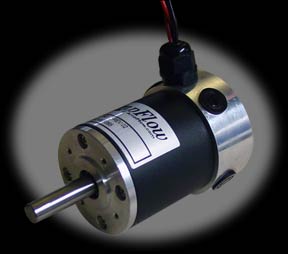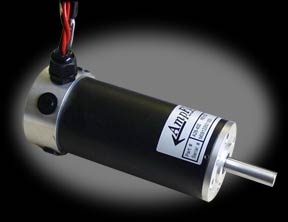Ampflow Motors have been specifically designed and battle-hardened for use in the BattleBots robot combat competition. They have also been used in applications like motorized scooters, electric bicycles, and small electric motorcycles with excellent results. Take a look at the specifications of the Ampflows. We think that you will agree that these are the ultimate motors for combat robots. We offer three different motors for combat robots:
Click here to go back to the main Ampflow motor page or to purchase
What makes a good motor?
Let's look at each of these questions in detail and see how the Ampflows handle them. Horsepower and Torque RPM Range Solid Construction - Easy Mounting Some motors use an internal fan to keep them from overheating. The Ampflows are efficient enough to operate without a fan. This has three advantages: (1) The motor housing is completely sealed so nothing can enter the motor and damage it; (2) The sealed motor tends to contain interference-causing radio frequency noise that would otherwise escape through the ventilation holes; (3) The power that would normally be used to run the fan can go directly to driving your robot. The armature rides in two large high-quality ball bearings and it is dynamically balanced using epoxy rather than by the normal method of drilling the laminations. Drilling can cause eddy currents in the laminations, which increase motor heating. Each of the four brushes has its own heavy-duty motor lead made from mil-spec 10-gauge flexible stranded wire, (12-gauge for the A28s). Each copper strand is coated with pure silver to protect against oxidation and to get the lowest possible resistance in crimped connections. These leads are flexible but not "floppy", so they tend to stay where you put them. The four leads have high-temperature Teflon insulation rated for 200ƒ C, (392ƒ F), so they can handle high current without melting. Efficiency
As you can see from the above chart, the efficiency of the motors is very high over a broad range of power. Please note that all our performance numbers are from motors that have neutral timing. Most motor manufacturers quote efficiency numbers from motors that have advanced timing. Advanced timing is a bad idea when you need to run the motor in both directions. Our motors are shipped with neutral timing for good operation in both directions. If you use the motor in one direction only, you can advance the timing and get even more RPM and power. (But do not run the motor backwards if the timing is advanced). Timing adjustment is easy with the Ampflows. The armatures are wound with very heavy gauge wire, and all the space in the armature is used. We left no power-robbing "empty air" in the slots; they are packed with copper! The A28s have skewed armature laminations to eliminate the heavy "cogging" that results from using the extremely powerful neodymium magnets. The A40 motor uses straight laminations, but the cogging is kept to a very low level by using a 42-bar commutator. The huge 1.75" diameter of the commutator combined with the four massive brushes and the 42 bars enabled us to get high power and high efficiency from this smooth-running motor, (the A28s have 21 bars). As far as we know, the Ampflows have the highest efficiency of any 24-volt reversible permanent magnet DC brush motors in their size ranges. Another benefit of the four-brush, 42 and 21-bar designs is the absence of excessive electrical noise. While all motors produce some electrical noise, cheaper motors with fewer commutator bars are more likely to send noisy voltage spikes back to your controller. This can destroy your expensive electronics. With more bars, each time a brush comes into contact with a new bar, the timing of the winding connected to that bar is closer to being optimal. In low-quality motors with fewer bars, each winding will pass through a wider range of angular offset from the magnets. This causes the brush to spark more and generates more electrical noise and voltage spikes. Built-in Capacitors Save Weight Motors that are used in the heavy and super-heavyweight classes range from about 8 to about 26 pounds. Motors for the light and middleweight classes range from about 2 to about 8 pounds. The A40 weighs in at 11.9 pounds. The A28-400 tips the scale at 6.9 pounds, and the A28-150 is just 3.8 pounds. A28-150
- Just 3.8 Pounds! Even the best 12-volt batteries in the 16 Amp-hour size range have an internal resistance of at least .007 Ohms each. Your controller will have at least .002 Ohms. The motors have between .042 and .064 Ohms. Add to that another .004 Ohms for your connectors, switches, and wiring, and you will have a circuit with between .062 and .084 Ohms. This gives theoretical maximum current draws of 285 Amps (A28-150), 340 Amps (A40), and 390 Amps (A28-400). The actual figures will be even lower if you have any other load on the battery (due to battery voltage droop). This puts the current draw within the range that some commercial speed controllers can handle. We suggest that you use controllers from Vantec, IFI, Robot Solutions, or Robot Power . The motors have seen action in the BattleBots competition with the Vantec RSFR38E, RSFR47E, the 4QD-300, and the OSMC and all controllers worked fine. We have also seen the motor used with two IFI Victors or Thors per motor (one on each set of motor leads); this has also worked fine. The motors have also been run with the Vantec RDFR47E and RDFR38E which are "dual" controllers that can operate two motors independently. We don't recommend the dual controllers, but they have worked. In a recent survey of all the people who used the Ampflows at BattleBots, there was not a single report of a controller failure! There are a few ways to reduce the wear and tear on your controller. One trick is to gear your robot so that it would be impossible to stall the motors. The more speed reduction you use, the easier it will be on your motors and controllers. Ten MPH might not sound very fast, but in the cramped BattleBox it is very difficult for the larger robots to take advantage of speeds much in excess of this (unless your primary mode of attack is ramming). More gear reduction will also give you faster acceleration and maneuverability. Another trick is to use batteries that can't produce this high current. If you are worried about your controller - just don't use those batteries. You should still get close to the full 4.5 horsepower using most other batteries because, (like all PMDC motors) the Ampflows produce their maximum power at 50% of their maximum RPM, and the current draw at that speed is no more than 240 Amps, (280A for the A28-400, 180A for the A28-150). Here are some tips for battery selection. The A40 and A28-400 have tested fine with momentary current draws of over 500 amps but if you are using any high-performance motors in your weapon and your weapon becomes stalled, you must back off on the throttle to prevent damage to the motors. By the way, one of the "rules of thumb" for determining if a motor is high in quality and efficiency is the difference between the no-load current, and the maximum current. A good motor might be able to draw 50 times its no-load current when stalled. Some very inefficient motors can do no better than 10 times or so. With a no-load currents of of 3.5 Amps (4.5 Amps for the A28-400), the Ampflows can draw an amazing 110 to 137 times their no-load currents! Here are some tips for break-in, repair, timing adjustments, and technical specifications. The A28-400 Ampflow Overvolting Choosing your motor
*NCW = Non continuous weapon (hammer, lifter etc.) Warrantee Customer Service Price and Shipping The A28-400 is smaller than the A40 so we can use neodymium rare earth magnets in that motor and still keep the price reasonable. The A28-150 uses less neodymium than the A28-400 so we are able to price it even lower. If you calculate the cost per horsepower, and the horsepower per pound of other available motors, you will see what great values these are.
"That's
a beautiful motor! Wow. Good work. Great price. This should
become standard equipment for all large robots." "As the BattleBot
competitions continue to grow, participants are constantly trying
to make their robots quicker, stronger and faster. With nearly
four horsepower and 3840 oz-in torque, the 11.9-pound A40 Ampflow
is ideally designed for our participants. Since power is often
the deciding factor in BattleBot competitions, more and more participants
are selecting Ampflows to power their robots with a lightweight,
high-efficiency motor that provides plenty of power on demand." "As the first motor
designed specifically for robotic combat, the Ampflow performs
fabulously! It combines incredible power and some of the best features
you could ask for when looking for a high-end motor for a BattleBot.
It is the most powerful and finest constructed DC permanent magnet
motor that I've ever used. I chose Ampflows for the weapon motor
in Nightmare and I am definitely a very satisfied customer!" "The Ampflow packs
a lot of power into a light-weight package. They give Minion the
power it needs and I still have weight to spare!" "Get the best motors
you can afford. Good motors are the foundation upon which all else
rests. People can win with hokey electronics or even with inoperative
weapons, but good motors make good robots." "We were extremely
pleased with the performance of the 4" Ampflow in our middleweight Heavy
Metal Noise at BB 4.0. The motor supplied an insane amount
of energy to our kinetic disk weapons. Time to spinup was minimal
and after combat the motor was never more than mildly warm to the
touch." "I've been building
robots as a hobby for about 30 years and this is definitely one
of the best motors (power, weight, cost, quality), that I've ever
encountered. Since I've never built a 'BattleBot' before, I decided
to focus most of my attention on other aspects of the design and
having this motor meant that I didn't have to spend many hours
'tweaking' an inferior motor just be competitive." "I can attest to their
super high quality of craftsmanship and design. We tested them
with a few different controllers and monitored the results using
a Tektronix digital scope and a digital ammeter. Results: This
is the largest motor we have tested and amazingly it had the cleanest
feedback signal of any motor yet. Generally the higher the quality
of motor mechanics, windings, brush and commutator, the cleaner
this signal is. This means these motors are less likely to blow
a speed controller due to transient voltage spikes. |
 The
quest for the perfect motor is one that all BattleBots competitors
have gone through. There are several choices available but as many
competitors have found, only a few of them will work well in battle.
The
quest for the perfect motor is one that all BattleBots competitors
have gone through. There are several choices available but as many
competitors have found, only a few of them will work well in battle. Using Your Ampflow motor
Using Your Ampflow motor 